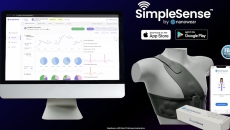smart clothing
Providers can use SimpleSense to remotely triage cardio, pulmonary and upper vascular patients.
Engineers from Tufts University demonstrate a new sensor for sweat detection, and Nanowear is teaming up with the New York City-Metro Health Systems to focus on remote detection of COVID-19.
The amount secured was not disclosed by the company.
